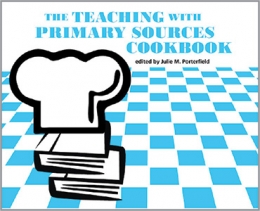Primary tabs
You don't need to be an ALA Member to purchase from the ALA Store, but you'll be asked to create an online account/profile during the checkout to proceed. This Web Account is for both Members and non-Members.
If you are Tax-Exempt, please verify that your account is currently set up as exempt before placing your order, as our new fulfillment center will need current documentation. Learn how to verify here.
- Description
- Table of Contents
- About the author
As records of firsthand accounts, primary sources reveal something about their creators and cultural context. Combining these two elements is a recipe for a transformative classroom experience. The Teaching with Primary Sources Cookbook brings together the work of archivists, librarians, museum professionals, and other educators who evoke the power of primary sources to teach information literacy skills to a variety of audiences.
The Cookbook is divided into six sections, with an appendix containing the full text of the Guidelines for Primary Source Literacy developed by a Society of American Archivists and ACRL’s Rare Books and Manuscript Section joint task force:
- Meal Prep: Teaching Archival Literacy
- Good Orderer: Teaching Search and Discovery in Archives and Special Collections
- Food Critics: Teaching Primary Source Literacy
- Something from the Cart: Exhibitions as Teaching and Learning
- Takeout: Teaching with Digital Collections
- Community Picnics: K–12 and Non-Course-Related Instruction
This work aims to provide an entry point for those new to teaching with primary sources and to be a repository of creative ideas for experienced instructors to refresh their lesson plans. It also endeavors to bring together the sometimes disparate realms of each of the professional niches of its authors.
Acknowledgments
Introduction
Section 1. Meal Prep: Teaching Archival Literacy
Chapter 1. You Can Research THAT?! An Introduction to Special Collections
Kay Clopton and Kapil Vasudev
Chapter 2. Remembering Your Collections: Creating a Memory Game to Teach about Special Collections and Archives
Tara Maharjan
Chapter 3. Creating Descriptive Metadata with Undergraduate Students
Irina Rogova
Section 2. Good Orderer: Teaching Search and Discovery in Archives and Special Collections
Chapter 4. Deconstructed Finding Aid Puzzle
Stefani Baldivia
Chapter 5. The Element of Surprise: How Much Does the Finding Aid Tell You about That Box?
Nina Mamikunian
Chapter 6. Three-Layer Primary Source Dip: Introducing History Students to Primary Source Research through Active Learning
Brittany O’Neill
Section 3. Food Critics: Teaching Primary Source Literacy
Chapter 7. Red Beans and Rice or Gumbo: Identity, the South, and Entry-Level English Classes
Jennifer Brannock
Chapter 8. A Metacognitive Approach to Teaching Critical Primary Source Literacy and Discovery
Ashleigh Dior Coren and K. Sarah Ostrach
Chapter 9. Fancy Dinner Date: Conversing with Artists’ Books to Spark Creativity
Laura Dimmit Smyth, Leslie Hurst, and Suzan Parker
Chapter 10. Cornhusker Casserole: Mixing Historical Research with Archives and Special Collections
Mary Ellen Ducey and Janel Simons
Chapter 11. Whipping Up Student Research Questions: Primary Source Analysis and Interrogation
Chloe Gerson and Laura Hibbler
Chapter 12. Two Chefs Are Better Than One: Partner Image Analysis
Kayla Harris
Chapter 13. Writing Postcards to the Past: Using Archival Images to Develop Visual Literacy Skills
Carly Marino and Janelle Adsit
Chapter 14. Hidden Ingredients: Using Archival Materials to Detect the Flavors of Social Power
Tom Philo
Chapter 15. Instant Archives: For Researchers on the Go
Laurinda Weisse
Chapter 16. Sampling the Hors d’Oeuvres: Exploratory Poetics in Archives and Special Collections
Patrick Williams
Section 4. Something from the Cart: Exhibitions as Teaching and Learning
Chapter 17. Can I Borrow a Cup of Sugar? Teaching with Collections from Digital Repositories
Maureen Cech and Meredith Knoff
Chapter 18. Cooking Up Curators
Derek Quezada and Jenna Dufour
Chapter 19. Creating a Showstopper: Student-Curated Exhibitions
Katherine Kapsidelis and Lindsay O’Neill
Chapter 20. Never Too Many Cooks in the Kitchen: Interdisciplinary Collaboration in Exhibition Creation
Bailey Rodgers, Melissa Minds VandeBurgt, and Carey Walker
Chapter 21. Photo Pop-Ups, or An Exhibit Is Worth a Thousand Words: Contextualizing Photographs through Primary Sources
Kathelene McCarty Smith
Section 5. Takeout: Teaching with Digital Collections
Chapter 22. Learning Visual Literacy with WWI Posters
Cynthia Bachhuber
Chapter 23. Community Potluck Chili
Kristin Conlin and Fatemeh Rezaei
Chapter 24. Database Dishes
Nathalie Cooke and Nora Shaalan
Chapter 25. The Sweet Taste of Suffrage: Key Voices in the Suffrage Movement in Tennessee
Jenny Harris and Nicole Wood
Chapter 26. Perfect Pairings: Integration of Digital Primary Sources with Secondary Sources
Rachel Grove Rohrbaugh
Chapter 27. Digital Archive Surprise with Primary Sources
Katy Walker and Kelle Roberts
Section 6. Community Picnics: K–12 and Non-Course-Related Instruction
Chapter 28. A Potluck of Expertise: Inviting Boston Public Schools’ Juniors to Use Northeastern’s Archives and Special Collection’s Pantry to Build Their Recipes
Molly Brown and Regina Pagani
Chapter 29. Spicing Things Up: Engaging Elementary School Students with Primary Sources
Samantha Crisp
Chapter 30. A Community Cake: Developing a New Monument with Primary Sources
Jessica Cruz and Jaycie Vos
Chapter 31. A Neighborhood Picnic: Creating an Educational Partnership with Local Retirement Communities
Kathelene McCarty Smith
Chapter 32. Create, Transform, and Connect: Fostering Arts-Based Community Partnership at Bronx Community College’s Archives
Cynthia Tobar
Appendix A: Guidelines for Primary Source Literacy
Appendix 1. Glossary of Terms Used in These Guidelines
Appendix 2. Annotated Bibliography
Appendix 3. Related Resources
Appendix 4. Background on the Development of These Guidelines
Julie M. Porterfield
Julie M. Porterfield serves the Penn State University Libraries as both the Instruction & Outreach Archivist for the Eberly Family Special Collections Library and the Women's, Gender, & Sexuality Studies Librarian for circulating collections. She graduated with a MA in Global Women's History in from Seton Hall University in 2011 and a MLIS from the University of Pittsburgh in 2013. She is an active member of the Society of American Archivists (SAA) and is currently the Reference, Access, & Outreach Section's Immediate Past Chair. Her work focuses on women and feminism in archives, archival outreach to campus and community groups, and teaching archival and primary source literacies with critical pedagogical techniques.



